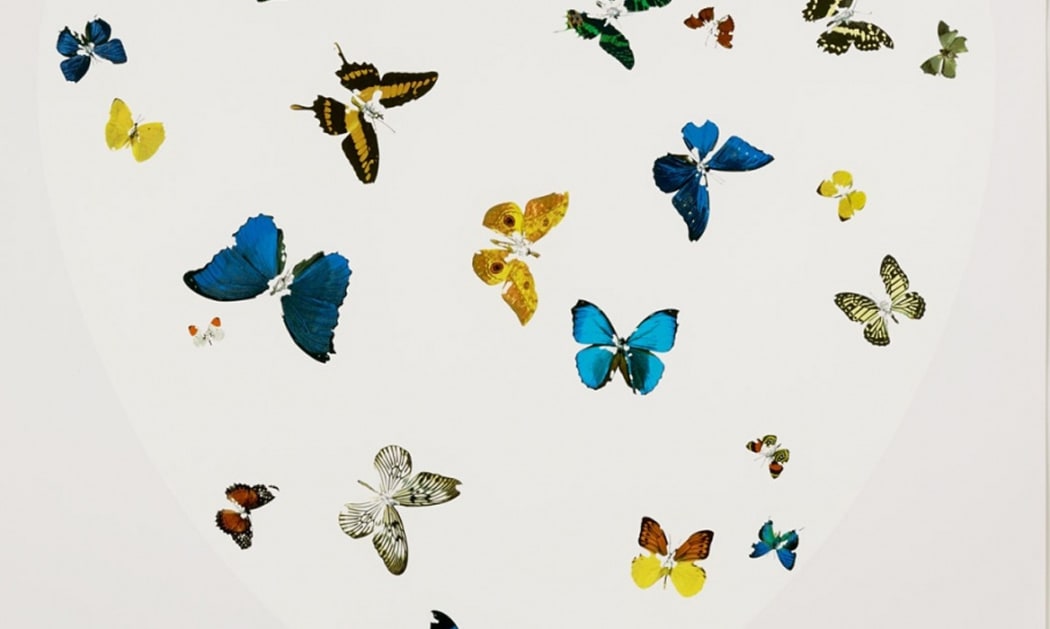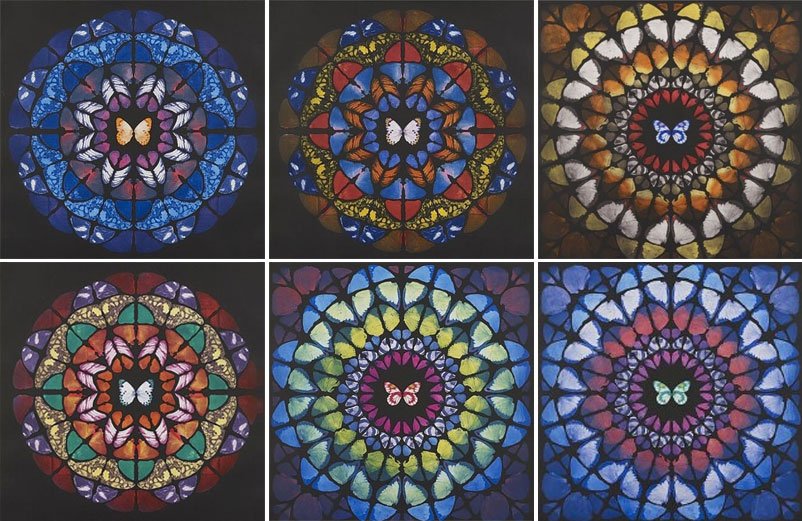
In and Out of Love
Organised in a former travel agency in Woodstock Street, London. ‘In and Out of Love’ consisted of two works. In the first space, ‘In and Out of Love (White Paintings and Live Butterflies)’ (1991) was presented, whilst the downstairs ‘In and Out of Love (Butterfly Paintings and Ashtrays)’ (1991).
In the tropical upstairs space, butterflies emerged from pupae attached to white painted canvases. Flowers and sugar water were provided to the butterflies that allowed them to fly, mate and lay eggs until they died. Downstairs, monochrome gloss paintings, with the bodies of dead butterflies fixed into the paint, surrounded a central table dotted with overflowing ashtrays. Hirst explained of the exhibition: “I tried to make a comparison between art and life in the upstairs and downstairs installations, a crazy thing to do when in the end it’s all art.”
‘In and Out of Love (Butterfly Paintings and Ashtrays)’ was the first exhibition of works from Hirst’s series of butterfly monochrome paintings. Following the show, a detail from one of the works was featured on the cover of the first edition of ‘Frieze’ magazine United for the first time since their initial release, they both appeared at Tate Modern’s 'Damien Hirst' retrospective for the first time since their exhibition at Woodstock Street.
The Souls of Jacob’s Ladder
Created in 2007, Hirst’s The Soul’s on Jacob’s Ladder Take their Flight shows the artist’s interest in religious themes and the butterfly motif. Signed on the front and numbered on the reverse, the prints share the same composition and show a vividly coloured butterfly set against a sparse, black background.
The stark contrast between the richly detailed, colourful butterflies and abyss of black creates a tension within each work. We are reminded of the fragility and innocence that the butterfly represents and life can be seen in the butterflies that is juxtaposed with the background that can be read as nothingness and of death. The beauty of the butterfly can be seen in its fleeting existence and short life span that can make us question our own mortality. The butterfly for Hirst is an endless source of inspiration where life and death intersect saying, “I love butterflies because when they are dead they look alive.”
To create the works, Hirst chose six real butterflies that were scanned and scaled up to create digital files that were then used for the gravure plates. The image was then etched into the plate by exposing gelatin-coated copper plates to the films which were then placed in acid baths. A second plate, inked in black, was then used to create more depth in the dark background.
Memento
Memento is a series of 13 etchings by Hirst that show two of his most famous motifs: butterflies and skulls. The series is made of six prints of butterflies, six of skulls and one of a diamond skull, each image is based around the same composition: the subject matter sett to a black background.
In Memento the recurring themes of death and life, a tension and duality that Hirst often employs, oscillate and it is this distinct style that has led Hirst to become the richest living artist and to gain both commercial and critical success. The subjects attack the viewer and seemingly radiate from the prints, enveloping the viewer in their beauty and fragility.
The butterflies and skulls are captured in photo-realistic detail that suggest the important documenting of facts and truth - leaving no space for a hoax. The butterflies are the life affirming ying to death’s yang and the hypnotic rhythms of the two seemingly swing back and forth like the clockwork movements of a metronome.
Clinical and cold, the butterflies in the first half of the Memento series and the skulls in the second half play host to birth, death and the transitory nature of existence. 
Sanctum Series
Hirst’s 2009 Sanctum Series consists of 6 etchings, each showing the artist’s obsession with creating kaleidoscopic patterns from butterfly wings whilst expanding on the religious themes seen in Memento. Each print shows a highly detailed, kaleidoscopic pattern produced from the neatly arranged butterfly wings. The works themselves present mortality and our attempt to understand death which is a central theme in his works. Like the stained glass windows of the great European gothic cathedrals, themselves a conduit to the divine and death, the work recalls towering odes to God. Of humanity itself crying out for anything that can remove the human condition and sin. In place of the figure of man is the figure of a butterfly - known for their short life spans and transformational existence.
Central to the series are the central butterfly, the only intact inset within the pieces, surrounded by disembodied butterfly wings creating a kaleidoscopic effect through a beautifully vibrant use of colour that contrasts with the dark background. Sanctum brings unites themes of science, aesthetics and religion through the use of the butterfly both in their aesthetic and the names inspired from areas within a cathedral. 
For more information on our Damien Hirst prints for sale contact Andipa via sales@andipa.com or call +44(0)20 7589 2371.